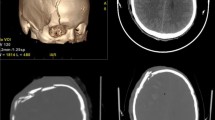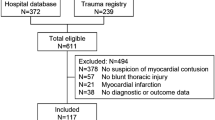Abstract
Background
The incidence of cardiac injury in immediate fatalities after blunt trauma remains underestimated, and reliable diagnostic strategies are still missing. Furthermore, clinical data concerning heart-specific troponin serum levels, injury severity score (ISS), catecholamine treatment and survival of patients on admission to the hospital have rarely been interrelated so far. Therefore, the object of the present study was to identify predictive parameters for mortality in the context of blunt cardiac injury.
Methods
This retrospective observational study included 173 severely injured patients with an ISS ≥25 admitted to the University Hospital of Ulm, a level 1 trauma center, during 2009–2013 . Furthermore, 83 blunt trauma victims who died before hospital admission were subjected to postmortem examination at the Institute of Legal Medicine, University of Ulm, during 2009–2014. ISS, cardiac injury and associated thoracic injuries were determined in both groups. Furthermore, in the hospitalized patients, serum troponin and IL-6 levels were measured.
Results
Macroscopic heart injury was observed in 18 % of the patients who died at the scene and only in 1 % of the patients admitted to the hospital, indicating that macroscopic heart injury is associated with an immediate life-threatening condition. Troponin levels were elevated in 43 % of the patients after admission to the hospital. Moreover, troponin serum concentrations were significantly higher in patients treated with norepinephrine (26.4 ± 4 ng/l) and in non-survivors (84.9 ± 22.8 ng/l) compared to patients without catecholamines and survivors, respectively.
Conclusions
Macroscopic heart injury was 20 times more frequent in non-survivors than in survivors. Serum troponin levels correlated with mortality after multiple injury and therefore may represent a valuable prognostic marker in trauma patients.



Similar content being viewed by others
References
Sybrandy KC, Cramer MJM, Burgersdijk C (2003) Diagnosing cardiac contusion: old wisdom and new insights. Heart 89(5):485–489
Elie MC (2006) Blunt cardiac injury. Mt Sinai J Med 73(2):542–552
Huber S, Biberthaler P, Delhey P, Trentzsch H, Winter H, van Griensven M, Lefering R, Huber-Wagner S, and DGU TR. Predictors of poor outcomes after significant chest trauma in multiply injured patients: a retrospective analysis from the German Trauma Registry (Trauma Register DGU (R)). Scandinavian Journal of Trauma Resuscitation & Emergency Medicine. 2014;22:52
Skinner DL, Laing GL, Rodseth RN, Ryan L, Hardcastle TC, Muckart DJ (2015) Blunt cardiac injury in critically ill trauma patients: a single centre experience. Injury. 46(1):66–70
Theodoropoulos I, Cheeyandira A, Tortella BJ (2013) Traumatic Tricuspid Valve Rupture Presenting as Third-Degree Atrioventricular Block. J Emerg Med 45(2):175–177
Kusumoto A, Miyata M, Kubozono T, Ikeda Y, Shinsato T, Kuwahata S, Fujita S, Takasaki K, Yuasa T, Hamasaki S et al (2012) Highly sensitive cardiac troponin T in heart failure: comparison with echocardiographic parameters and natriuretic peptides. J Cardiol 59(2):202–208
Baker SP, O’Neill B, Haddon W Jr, Long WB (1974) The injury severity score: a method for describing patients with multiple injuries and evaluating emergency care. J Trauma 14(3):187–196
Wisner DH, Reed WH, Riddick RS (1990) Suspected myocardial contusion. Triage and indications for monitoring. Ann Surg 212(1):82–86
Huang YK, Lu MS, Liu KS, Liu EH, Chu JJ, Tsai FC, Lin PJ (2010) Traumatic pericardial effusion: impact of diagnostic and surgical approaches. Resuscitation. 81(12):1682–1686
Ritchie D, Trott T, Bryant J, Stearley S, Adkins B (2013) Takutsubo Cardiomyopathy and Flash Pulmonary Edema in a Trauma Patient. J Emerg Med 45(4):530–532
Odell DD, Peleg K, Givon A, Radomislensky I, Makey I, Decamp MM, Whyte R, Gangadharan SP, Berger RL, and Israeli Trauma G. Sternal fracture: isolated lesion versus polytrauma from associated extrasternal injuries–analysis of 1,867 cases. J Trauma Acute Care Surg. 2013;75(3):448-52
Dua A, McMaster J, Desai PJ, Desai SS, Kuy S, Mata M, and Cooper J. The Association between Blunt Cardiac Injury and Isolated Sternal Fracture. Cardiol Res Pract. 2014;2014(629687
Rashid MA, Ortenwall P, Wikstrom T (2001) Cardiovascular injuries associated with sternal fractures. Eur J Surg 167(4):243–248
Mirvis SE (2005) Imaging of acute thoracic injury: the advent of MDCT screening. Semin Ultrasound CT MR 26(5):305–331
Paone RF, Peacock JB, Smith DLT (1993) Diagnosis of Myocardial Contusion. South Med J 86(8):867–870
Hanschen M, Kanz KG, Kirchhoff C, Khalil PN, Wierer M, van Griensven M, Laugwitz KL, Biberthaler P, Lefering R, Huber-Wagner S et al (2015) Blunt Cardiac Injury in the Severely Injured - A Retrospective Multicentre Study. PLoS ONE 10(7):e0131362
Moore EE, Malangoni MA, Cogbill TH, Shackford SR, Champion HR, Jurkovich GJ, McAninch JW, Trafton PG (1994) Organ injury scaling. IV: thoracic vascular, lung, cardiac, and diaphragm. J Trauma 36(3):299–300
Bertinchant JP, Robert E, Polge A, de la Coussaye JE, Pignodel C, Aya G, Fabbro-Peray P, Poirey S, Ledermann B, Eledjam JJ et al (1999) Release kinetics of cardiac troponin I and cardiac troponin T in effluents from isolated perfused rabbit hearts after graded experimental myocardial contusion. J Trauma 47(3):474–480
Collins JN, Cole FJ, Weireter LJ, Riblet JL, and Britt LD. The usefulness of serum troponin levels in evaluating cardiac injury. Am Surg. 2001;67(9):821-5; discussion 5-6
Bertinchant JP, Polge A, Mohty D, Nguyen-Ngoc-Lam R, Estorc J, Cohendy R, Joubert P, Poupard P, Fabbro-Peray P, Monpeyroux F et al (2000) Evaluation of incidence, clinical significance, and prognostic value of circulating cardiac troponin I and T elevation in hemodynamically stable patients with suspected myocardial contusion after blunt chest trauma. Journal of Trauma-Injury Infection and Critical Care. 48(5):924–931
Rajan GP, Zellweger R (2004) Cardiac troponin I as a predictor of arrhythmia and ventricular dysfunction in trauma patients with myocardial contusion. Journal of Trauma-Injury Infection and Critical Care. 57(4):801–808
Agewall S, Giannitsis E, Jernberg T, Katus H (2011) Troponin elevation in coronary vs. non-coronary disease. Eur Heart J 32(4):404–411
Karu I, Tahepold P, Sulling TA, Alver M, Zilmer M, Starkopf J (2009) Off-pump coronary surgery causes immediate release of myocardial damage markers. Asian Cardiovasc Thorac Ann. 17(5):494–499
Wan S, DeSmet JM, Barvais L, Goldstein M, Vincent JL, LeClerc JL (1996) Myocardium is a major source of proinflammatory cytokines in patients undergoing cardiopulmonary bypass. J Thorac Cardiovasc Surg 112(3):806–811
Boland TA, Lee VH, Bleck TP (2015) Stress-induced cardiomyopathy. Crit Care Med 43(3):686–693
Pfortmueller CA, Lindner G, Leichtle AB, Fiedler GM, Exadaktylos AK (2014) Diagnostic significance of high sensitivity troponin in diagnosis of blunt cardiac injury. Intensive Care Med 40(4):623–624
Author information
Authors and Affiliations
Corresponding author
Ethics declarations
Conflict of interest
The authors declare no commercial or financial conflicts of interest related to the studies.
Electronic supplementary material
Below is the link to the electronic supplementary material.
Rights and permissions
About this article
Cite this article
Kalbitz, M., Pressmar, J., Stecher, J. et al. The Role of Troponin in Blunt Cardiac Injury After Multiple Trauma in Humans. World J Surg 41, 162–169 (2017). https://doi.org/10.1007/s00268-016-3650-7
Published:
Issue Date:
DOI: https://doi.org/10.1007/s00268-016-3650-7




